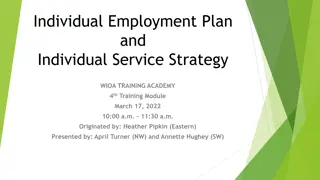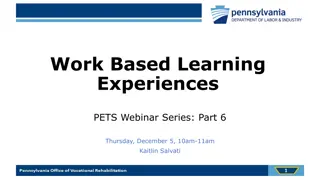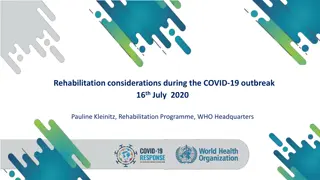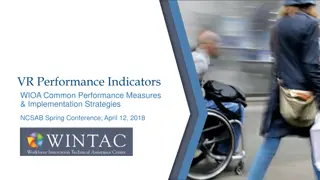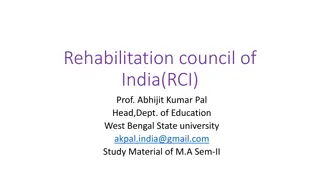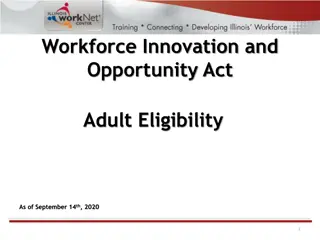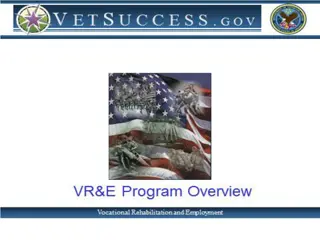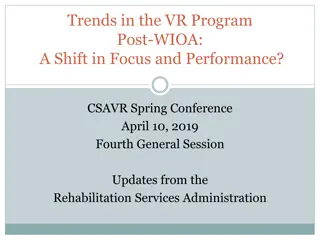Changes in Vocational Rehabilitation Program under WIOA
WIOA brought significant changes to the VR program, focusing on competitive, integrated employment for individuals with disabilities. The emphasis is on equal earnings, integrated locations, and advancement opportunities to meet the definition of competitive integrated employment.
Download Presentation

Please find below an Image/Link to download the presentation.
The content on the website is provided AS IS for your information and personal use only. It may not be sold, licensed, or shared on other websites without obtaining consent from the author.If you encounter any issues during the download, it is possible that the publisher has removed the file from their server.
You are allowed to download the files provided on this website for personal or commercial use, subject to the condition that they are used lawfully. All files are the property of their respective owners.
The content on the website is provided AS IS for your information and personal use only. It may not be sold, licensed, or shared on other websites without obtaining consent from the author.
E N D
Presentation Transcript
[AT121][508][V2X/SL] COT usage scenario and LCP enhancement (OPPO) Scope: Clarify the COT usage scenarios (excluding reception of multiple COTs) and discuss how to handle each scenario (including LCP enhancement on L2 destination id and/or CAPC restriction). With consideration of RAN1 agreements. Intended outcome: Discussion summary in R2-2302035 Deadline: Comeback at 3/3 CB session
Background Proposal 3 whether the selected Destination is associated with the COT initiating UE and CAPC value). [LG]: Support the proposal. Minimum change of LCP is required to use COT (based on RAN1 agreements). [Xiaomi]: For L2 destination id aspect, it is still FFS in RAN1. For CAPC aspect, we can consider alternative solution (e.g. assistance information is provided by responding UE to initiating UE, the initiating UE assigns based on the received information, then we may not need LCP change in the responding UE when COT is used). [Ericsson]: L2 destination id restriction is clear at least for UC (to RAN1 agreement). [Lenovo]: Support the proposal. [Vivo]: It is similar to a NR-U case where DCI indicates CAPC value, but in NR-U there was no change of LCP due to that. [Huawei, Lenovo]: It was not specified because it was clear requirement. Also it is for mode 1 operation, so the gNB is well aware of the status of the UE. [LG]: Compared to NR-U, in SL-U LCP has a L2 destination id selection. [OPPO]: Companies may want to see whole cases and see the solution for each case. In the LCP procedure, the responding UE considers the COT info (i.e., including
Observation It seems there would be anyway some cases where the COT cannot be used, (e.g., 1/ MAC PDU generated before COT arrival which does not satisfy the COT requirement, or 2/ MAC PDU has not been generated but no data in RLC buffer satisfying COT requirement and etc.) It seems there would be anyway cases where the COT can be used (e.g., if following legacy LCP, the generated MAC PDU already satisfies the COT requirement)
Observation The key issue seems for the case where 1) If following legacy LCP (no change), the generated MAC-PDU does not satisfy the COT requirement 2) Yet if change LCP a bit (destination-selection and/or LCH- selection), the generated MAC-PDU can satisfy the COT requirement What the UE should do
Observation: Solutions on the table Solution-1: Make use of the COT (i.e., type-2 LBT) + an improved LCP to ensure MAC-PDU satisfy the COT requirement Solution-2: Not make use of the COT, but rely on type-1 LBT, and rely on the legacy LCP change
Q: How do we proceed Unless we identify infeasibility of solution-1 and/or solution-2 Way-out-A: trying to down-select between the 2 solutions Way-out-B: trying to allowing both, and up to UE to select which solution to use




